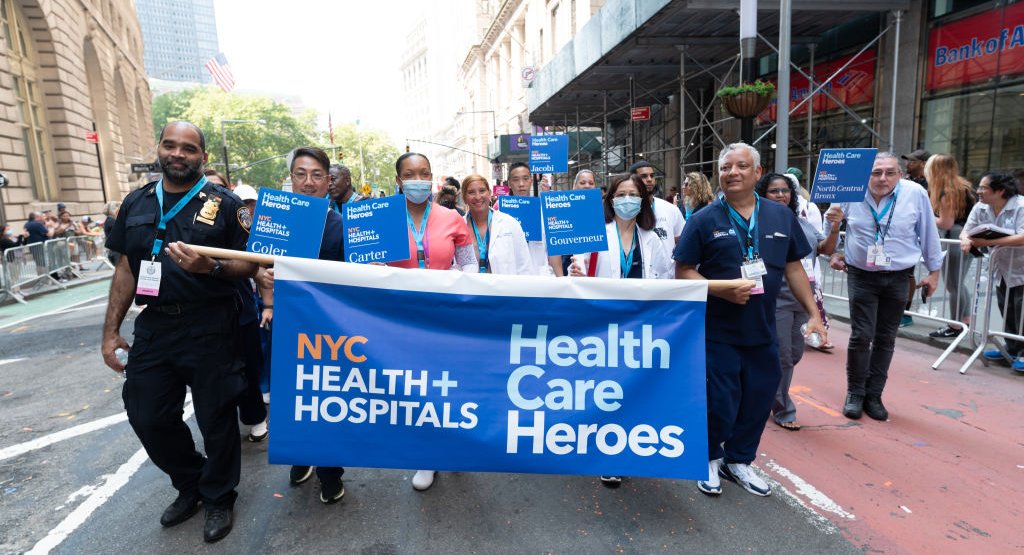Doctors at NYC Health and Hospitals will soon be directed to cut the amount of time they allot for primary care visits in half — a measure meant to squeeze in more new patients as demand for care at the city’s public health system grows, according to documents obtained by Gothamist.
Shortening each visit would allow new patients to get appointments faster, according to a presentation on the initiative authored by Dr. Ted Long, NYC Health and Hospitals’ senior vice president of ambulatory care and population health, and other executives. Gothamist obtained the internal presentation from a doctor in the health system, who requested anonymity for fear of retaliation.
The directive comes amid a dramatic increase in the average wait time for primary care appointments for new patients in the public health system. The wait time doubled for adults over the past year and increased 40% for children, according to the latest Mayor’s Management Report, published in January.
NYC Health and Hospitals did not immediately respond to a request for comment on the new directive or the timeline for its rollout.
Some doctors worry that shortening appointment times will diminish the quality of patient care and contribute to higher burnout rates among physicians in a public health system already struggling to compete with its private counterparts for clinical staff.
The Doctors Council SEIU, the union that represents physicians in the public health system, says NYC Health and Hospitals should focus on recruiting more doctors, rather than loading up employees’ patient rosters. The union is in the midst of negotiating with the city over a new contract.
“This is the wrong solution to a systemic problem that Doctors Council SEIU has been addressing at the bargaining table for almost a year and further highlights the retention and recruitment crisis the system is facing,” Dr. Frances Quee, president of the Doctors Council and a pediatrician at NYC Health and Hospitals’ Belvis clinic in the Bronx, said in a statement on the decision.
Quee said the health system “overstepped its boundaries by not including frontline doctors in this decision, to the detriment of the patients they serve and ultimately the City of New York.”
Health system leaders are ordering doctors to reduce the amount of time they spend on each visit from 40 minutes to 20 minutes, according to the presentation. But not all of the time budgeted for each visit is spent with patients, said Dr. Andrew Goldstein, a primary care doctor at Bellevue. Doctors also use that time to submit orders for medication and update patients’ files, he said.
“Sure, you get your first visit sooner, but it’s an inappropriate, unsafe amount of time that you’re being given,” Goldstein said.
He added that many of his patients need interpreters, which doubles the amount of time it takes to discuss their medical needs.
“Part of what makes the 20 minute patient visit an issue is that it’s a blunt policy that’s [being implemented] across the board,” rather than screening patients to determine how complex their medical needs are, Goldstein said.
“If someone was actually doing that screening and making an informed decision, to me that would be reasonable,” Goldstein added.
The system uses the “third next available appointment” as a standard measure to determine health care accessibility.
For adults, the average wait time for the third next available primary care appointment doubled to 22 days in the first four months of 2024, up from 11 days during the same period the previous year, according to the Mayor’s Management Report.
For children, the wait time increased 40%, from 15 days in the beginning of 2023 to 21 days in the beginning of this year, the report found. The “third next available appointment” is a standard measure used to determine health care accessibility.
The longer wait times come as patients increasingly return to in-person care after relying more heavily on telehealth visits during the pandemic, and as the health system continues to work to expand the population it serves, according to the Mayor’s Management Report.
Enrollment in NYC Care, which assigns uninsured patients to primary care providers at NYC Health and Hospitals, was up 16% at the beginning of this year compared with last year, the report found.
This is a developing story and may be updated.
